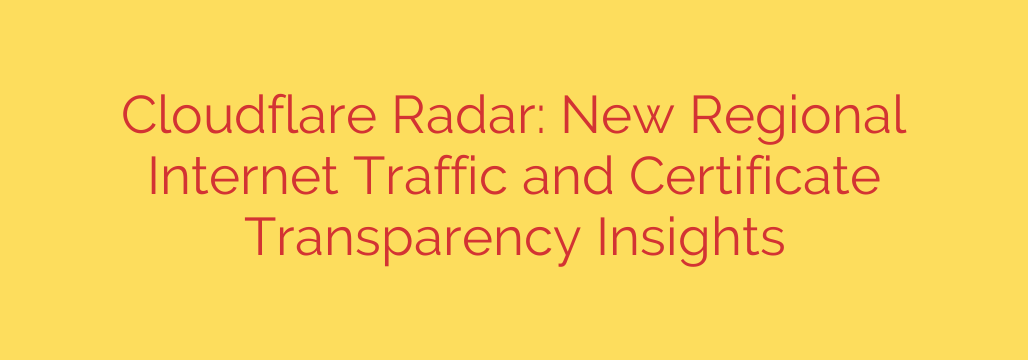
A Deeper Dive: Unlocking New Insights into Regional Internet Traffic and Web Security
The internet is the lifeblood of our modern world, connecting communities and powering economies. Understanding its ebbs and flows is crucial for everything from cybersecurity to economic analysis. While we often talk about internet traffic on a national scale, this broad view can mask significant events happening at a more local level.
Now, powerful new analytical capabilities are providing a much clearer picture, allowing us to zoom in on internet trends within specific regions, states, and provinces. At the same time, new tools are shedding light on the very foundation of web security: the issuance of SSL/TLS certificates. Let’s explore how these advancements are creating a more transparent and understandable digital world.
Moving Beyond National Averages: A Granular Look at Regional Internet Traffic
For years, analyzing internet traffic has largely been limited to a country-by-country view. This is useful, but it doesn’t tell the whole story. A nationwide blackout in a small country is easy to spot, but a significant outage affecting millions in a single US state or a Canadian province could be lost in the national average.
By breaking down internet traffic data to the sub-national level, we can now uncover insights that were previously hidden. This granular view allows anyone—from network engineers to journalists and researchers—to see how traffic patterns change within a country’s borders.
This regional approach offers several key advantages:
- Pinpoint localized internet disruptions. It’s now easier to identify if an outage is limited to a specific area, helping to distinguish between a regional network failure and a broader national event.
- Analyze the impact of regional events. We can observe how local holidays, severe weather events like hurricanes, or government-mandated shutdowns affect internet connectivity and usage in a targeted geographical area.
- Understand user behavior at a local level. Businesses and researchers can gain a more nuanced understanding of how different regions use the internet, leading to better-informed decisions and more accurate studies.
For instance, a major public holiday celebrated in one state might show a significant dip in office-related internet traffic there, while the rest of the country remains stable. This level of detail provides a far more accurate and actionable view of global internet health.
Enhancing Trust Online: The Growing Importance of Certificate Transparency
Every time you see a padlock icon in your browser’s address bar, you’re seeing an SSL/TLS certificate in action. These certificates are essential digital credentials that encrypt your connection to a website, protecting your data from eavesdroppers. But how do we know these certificates are legitimate and not issued fraudulently?
The answer lies in Certificate Transparency (CT), a critical security framework that acts as a public ledger for web security. Whenever a trusted Certificate Authority (CA) issues an SSL/TLS certificate, it must submit it to a public, independently operated log. This creates an open and auditable record of every certificate issued for every website.
New insights drawn from these public logs provide a powerful lens into the health of the web’s security ecosystem. Key benefits include:
- Detecting Mis-issued or Fraudulent Certificates. Website owners can monitor CT logs to ensure no one is issuing unauthorized certificates for their domains, which is a common tactic in sophisticated phishing attacks.
- Increasing Accountability for Certificate Authorities. With every issued certificate being public knowledge, CAs are held to a higher standard, as any errors or malicious activity can be quickly detected by the global security community.
- Providing Unprecedented Visibility. Anyone can now track trends in certificate issuance, see which CAs are the most active, and monitor which domains are securing themselves with new certificates over time.
This transparency is a massive step forward in building a more trustworthy internet, making it significantly harder for bad actors to impersonate legitimate websites and intercept sensitive user data.
What This Means for You: Actionable Security and Data Tips
These advancements aren’t just for data scientists. They offer practical benefits for everyone.
- For Website Owners and Developers: Proactively monitor certificate issuance for your domains. Use free CT monitoring tools to get alerts if an unexpected certificate is issued for your website. Additionally, leverage regional traffic data to understand where your users are coming from and to better troubleshoot connectivity issues reported by customers in a specific area.
- For Researchers and Analysts: Correlate internet activity with real-world events. The availability of regional data opens up new possibilities for studying the relationship between internet usage and socio-economic factors, policy changes, and natural disasters with much greater precision.
- For Everyday Internet Users: Continue to trust the padlock. The push for greater Certificate Transparency strengthens the security systems that protect you every day. Always ensure you see
https://and the padlock icon before entering sensitive information on any website. Be aware that local events, from power outages to major storms, can directly impact your connectivity.
By making both internet traffic patterns and the foundations of web security more visible, we are collectively building a more resilient, secure, and understandable internet for all.
Source: https://blog.cloudflare.com/new-regional-internet-traffic-and-certificate-transparency-insights-on-radar/








